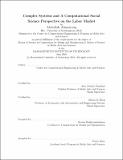Complex systems and a computational social science perspective on the labor market
Author(s)
Almaatouq, Abdullah
DownloadFull printable version (20.47Mb)
Alternative title
Computational social science perspective on the labor market
Other Contributors
Program in Media Arts and Sciences (Massachusetts Institute of Technology)
Massachusetts Institute of Technology. Computation for Design and Optimization Program
Advisor
Alex (Sandy) Pentland and Olivier de Weck.
Terms of use
Metadata
Show full item recordAbstract
Labor market institutions are central for modern economies, and their polices can directly affect unemployment rates and economic growth. At the individual level, unemployment often has a detrimental impact on people's well-being and health. At the national level, high employment is one of the central goals of any economic policy, due to its close association with national prosperity. The main goal of this thesis is to highlight the need for frameworks that take into account the complex structure of labor market interactions. In particular, we explore the benefits of leveraging tools from computational social science, network science, and data-driven theories to measure the flow of opportunities and information in the context of the labor market. First, we investigate our key hypothesis, which is that opportunity/information flow through weak ties, and this is a key determinant of the length of unemployment. We then extend the idea of opportunity/information flow to clusters of other economic activities, where we expect the flow within clusters of related activities to be higher than within isolated activities. This captures the intuition that within related activities there are more "capitals" involved and that such activities require similar "capabilities." Therefore, more extensive clusters of economic activities should generate greater growth through exploiting the greater flow of opportunities and information. We quantify the opportunity/information flow using a complexity measure of two economic activities (i.e. jobs and exports).
Description
Thesis: S.M., Massachusetts Institute of Technology, School of Architecture and Planning, Program in Media Arts and Sciences, 2016. Cataloged from PDF version of thesis. Includes bibliographical references (pages 99-109). Thesis: S.M.. Massachusetts Institute of Technology, Computation for Design and Optimization Program, 2016.
Date issued
2016Department
Massachusetts Institute of Technology. Computation for Design and Optimization Program; Program in Media Arts and Sciences (Massachusetts Institute of Technology)Publisher
Massachusetts Institute of Technology
Keywords
Program in Media Arts and Sciences ()